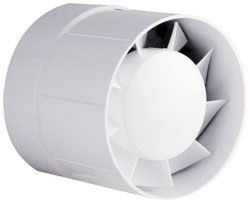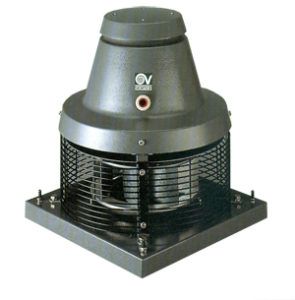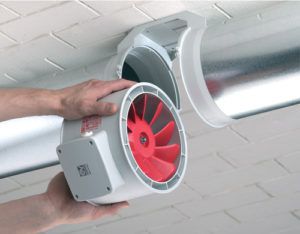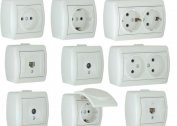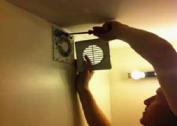Humid, stagnant, polluted air is removed from the premises through exhaust ventilation. Best of all, this function is performed by a duct fan installed directly in the ventilation duct.
At the same time, such devices can be used in any premises - both in home kitchens and in industrial facilities. Their main advantage is high performance, quiet operation and lack of vibration.
Types of duct fans
Depending on the shape, the channel fan may look like this:
- round - is the most popular variety, installed in round ventilation ducts;
- rectangular - are installed in channels with a rectangular or square section. Most often, such models are used in industry due to their high power;
- square - also used mainly in industry, designed for installation in square channels.
You should know that square and rectangular fans are made of metal, and high-quality plastic is used to produce round ones. Metal fans are much stronger and more durable, while plastic fans absorb noise better.
In addition, channel devices are divided into radial and axial:
- The axial exhaust fan is equipped with blades designed to move the pumped air along the axis on which the blades are mounted. This design is the most common among all types of duct fans. The advantages include low air resistance and economical energy consumption;
- radial models are spiral-shaped blades that spin air by centrifugal force, which then moves into a spiral casing. The incoming stream moves perpendicular to the outgoing air stream, which provides excellent suction power. Therefore, radial fans are effective in rooms with a large area.
For the manufacture of enclosures using metal or plastic. If the model is purchased for domestic use, then you can opt for a fan in a plastic case. If you plan to use the device in high-intensity mode at the enterprise, then you need to choose a product in a metal case. Such devices are much more expensive, because they can draw in more cubic meters of air over a certain period of time.
For example, when using a conventional household fan in the kitchen, the device can process up to 350 cubic meters of air, an industrial unit - about 17,000 cubic meters, and individual, heavy-duty models - up to 50,000 cubic meters.
How to choose a channel fan?
Before buying a hood fan, you should determine the size of the room in which the device will be installed. In most modern apartments you can use inexpensive axial fans with a capacity of up to 120 cubic meters. Such a device costs about $ 30. For rooms with a large area, it is necessary to choose the appropriate performance, being guided by the instructions supplied with the product.
In cases where the area of the room is small, and the ventilation duct in it is square, you can purchase a round fan, place it in the duct and close it with a square grill.
Channel ventilation can be on manual or automatic control. It can also be turned on with the light. To do this, open one supply wire and connect it to the light switch.
In addition, by installing a double switch, one key can be connected in the light, and the other to the fan. The device can be controlled using the remote control. In more expensive and advanced models, the speed of rotation of the blades is automatically adjusted.
Owners of private houses can pay attention to the fireplace duct fan, designed to draw the products of combustion of fuel.
Important! A conventional fan will not cope with such a task as pulling combustion products out of a fireplace.
When buying a device for a fireplace, it should be remembered that it must be equipped with double insulation and heat-resistant internal components.
Basic options for selection
- Choosing a hood with a fan, you need to focus on the size and shape of the cross-sections of the channels.
- It should be remembered that high-power fans are characterized by better performance, so when choosing it is worth paying attention to the power of the unit.
- An important parameter is air exchange: for a certain time, the device manages to completely completely change the surrounding air several times. The more often he does, the better. To determine this characteristic, the power of the unit is divided by the volume of the room.
- Another important characteristic is the air flow rate. The most optimal unit will be, issuing a speed of 11 to 14 m / s. If the speed is less than 11, then the device will be ineffective, and if more than 14, the noise level will increase sharply.
- If you want to purchase a low-noise fan, then the degree of noise can be determined by the shape of the impeller blades. So, a fan with forward-curved blades is more efficient, but in this case it will create a lot of noise. The blades with a rear bend allow the device to operate silently and economically.
- If the homeowner cares about saving the space of his premises, it is recommended that you choose a small device that fits seamlessly into the finished air duct.
In order for the exhaust fan in the living room to work silently, when choosing it, you should pay attention to the presence of a soundproof casing. Such devices have the following advantages:
- insulated housing prevents condensate from entering the unit;
- thanks to the sandwich panels of which the casing is made, the fan runs silently and does not vibrate.
Installation
You can install a duct fan anywhere in the duct. As a rule, its installation is carried out in the inlet of the duct. This place is especially true if the installation is performed independently. The unit body is equipped with holes for mounting it to the wall. As fasteners, you can use dowels.
Important! There is an arrow on the body of the device indicating the direction of the air flow, which must be observed during installation.
Installation is carried out in such a way that the device body fits snugly against the channel. Otherwise, during operation it will often fail and require repair, the cost of which in some cases may exceed the cost of the fan itself.
When using the air duct, it is docked with the fan with clamps. In this case, a cable channel or ceiling can be used to output an electric cable.
